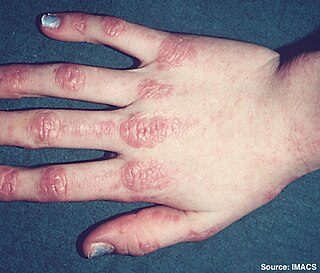Inclusion body myositis (IBM) [my-oh-SIGH-tis] is the most common inflammatory muscle disease in older adults. The disease is characterized by slowly progressive weakness and wasting of both distal and proximal muscles, most apparent in the finger flexors and knee extensors. IBM is often confused with an entirely different class of diseases, called hereditary inclusion body myopathies (hIBM). The "M" in hIBM is an abbreviation for "myopathy" while the "M" in IBM is an abbreviation for "myositis". These diseases should not be confused with each other. In IBM, two processes appear to occur in the muscles in parallel, one autoimmune and the other degenerative. Inflammation is evident from the invasion of muscle fibers by immune cells. Degeneration is characterized by the appearance of holes, deposits of abnormal proteins, and filamentous inclusions in the muscle fibers. sIBM is a rare disease, with a prevalence ranging from 1 to 71 individuals per million.

Juvenile dermatomyositis (JDM) is an idiopathic inflammatory myopathy (IMM) of presumed autoimmune dysfunction resulting in muscle weakness among other complications. It manifests itself in children; it is the pediatric counterpart of dermatomyositis. In JDM, the body's immune system attacks blood vessels throughout the body, causing inflammation called vasculitis. In the United States, the incidence rate of JDMS is approximately 2-3 cases per million children per year. The UK incidence is believed to be between 2-3 per million children per year, with some difference between ethnic groups. The sex ratio is approximately 2:1. Other Idiopathic inflammatory myopathies include; juvenile polymyositis (PM), which is rare and not as common in children as in adults.
IBM is International Business Machines, an American multinational technology and consulting corporation, with headquarters in Armonk, New York.

Dermatomyositis (DM) is a long-term inflammatory disorder which affects muscles. Its symptoms are generally a skin rash and worsening muscle weakness over time. These may occur suddenly or develop over months. Other symptoms may include weight loss, fever, lung inflammation, or light sensitivity. Complications may include calcium deposits in muscles or skin.

Polymyositis (PM) is a type of chronic inflammation of the muscles related to dermatomyositis and inclusion body myositis. Its name means "inflammation of many muscles". The inflammation of polymyositis is mainly found in the endomysial layer of skeletal muscle, whereas dermatomyositis is characterized primarily by inflammation of the perimysial layer of skeletal muscles.

Myositis ossificans comprises two syndromes characterized by heterotopic ossification (calcification) of muscle.
Myositis is inflammation or swelling of the muscles. Injury, medicines, infection, or an immune disorder can lead to myositis. It is a documented side effect of the lipid-lowering drugs statins and fibrates.

Pyomyositis, is a bacterial infection of the skeletal muscles which results in an abscess. Pyomyositis is most common in tropical areas but can also occur in temperate zones.

Sarcocystis is a genus of parasites, the majority of species infecting mammals, and some infecting reptiles and birds.
Mixed connective tissue disease, commonly abbreviated as MCTD, is an autoimmune disease characterized by the presence of high blood levels of a specific autoantibody, now called anti-U1 ribonucleoprotein (RNP). The idea behind the "mixed" disease is that this specific autoantibody is also present in other autoimmune diseases such as systemic lupus erythematosus, polymyositis, scleroderma, etc. It was characterized in 1972, and the term was introduced by Leroy in 1980.
Diabetic myonecrosis is a complication of diabetes. It is caused by infarcted muscle tissue, usually in the thigh.
Scleromyositis, is an autoimmune disease. People with scleromyositis have symptoms of both systemic scleroderma and either polymyositis or dermatomyositis, and is therefore considered an overlap syndrome. Although it is a rare disease, it is one of the more common overlap syndromes seen in scleroderma patients, together with MCTD and Antisynthetase syndrome. Autoantibodies often found in these patients are the anti-PM/Scl (anti-exosome) antibodies.

Inflammatory myopathy is disease featuring weakness and inflammation of muscles and muscle pain. The cause of much inflammatory myopathy is unknown (idiopathic), and such cases are classified according to their symptoms and signs and electromyography, MRI and laboratory findings. It can also be associated with underlying cancer. The main classes of idiopathic inflammatory myopathy are polymyositis (PM), dermatomyositis (DM), and inclusion-body myositis (IBM).
Although they vary in particulars, polymyositis, dermatomyositis and inclusion body myositis are idiopathic inflammatory myopathies (IIM) primarily characterized by chronic inflammation of human skeletal muscle tissue that ultimately causes the necrosis of muscle cells. This degeneration leads to muscle tissue wasting, weakness and fatigue among other serious effects. Until recently, exercise has been avoided as a type of therapy, and even forbidden due to the risk of triggering or amplifying inflammation. However, several studies have been conducted to test this assumption and have shown that aerobic exercise as well as resistance training can maintain and even improve quality of life for IIM-affected individuals without increased inflammatory response.
Bimagrumab (BYM338) is a human monoclonal antibody developed by Novartis to treat pathological muscle loss and weakness. On August 20, 2013 it was announced that bimagrumab was granted breakthrough therapy designation for sporadic inclusion body myositis (sIBM) by US Food and Drug Administration.
Anncaliia algerae is an aquatic unicellular parasite in the division microsporidium. A. algerae most commonly infects mosquitoes.








